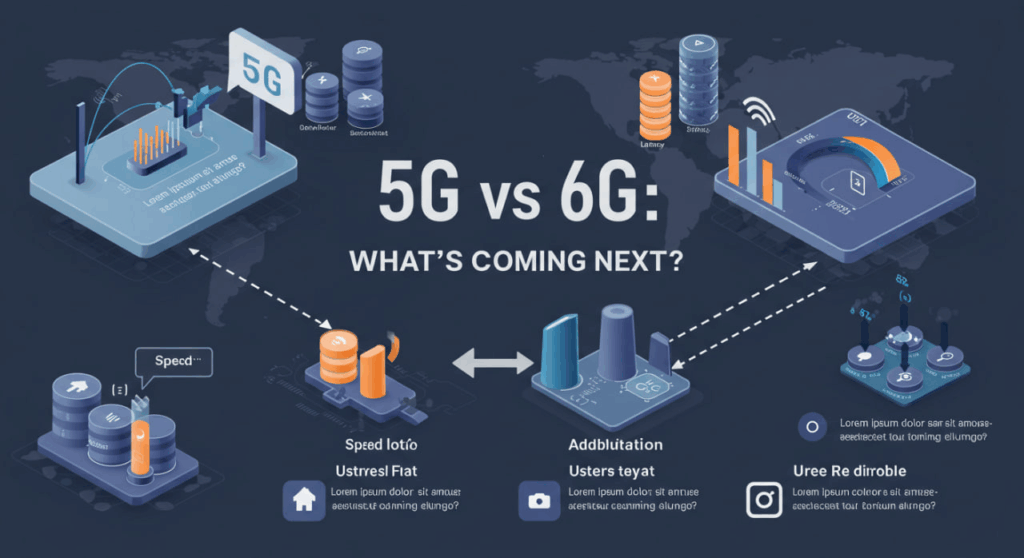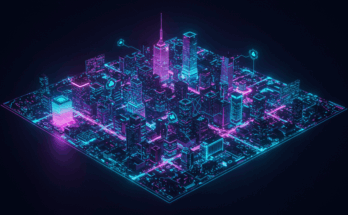The world of wireless communication is evolving at a breakneck pace, with 5G networks already transforming how we connect, work, and live. But even as 5G continues to roll out globally, the tech world is buzzing with anticipation for its successor: 6G. What exactly does 6G promise, and how does it stack up against 5G? In this article, we’ll dive deep into the differences, improvements, and potential game-changers that 6G could bring to the table. Whether you’re a tech enthusiast or just curious about the future of connectivity, this comparison will break down the key aspects of 5G and 6G in a way that’s engaging and easy to understand.
What is 5G and Where Are We Now?
The Foundation of 5G Technology
5G, the fifth generation of wireless networks, has been a game-changer since its commercial rollout began around 2019. Designed to deliver faster speeds, lower latency, and greater capacity than its predecessor, 4G, 5G has powered innovations like smart cities, autonomous vehicles, and enhanced mobile gaming. With peak speeds reaching up to 20 Gbps in ideal conditions and latency as low as 1 millisecond, 5G enables near-instantaneous data transfers, making it ideal for applications requiring real-time responsiveness, such as remote surgeries or augmented reality (AR) experiences.
Current Impact and Adoption of 5G
As of 2025, 5G networks are widely available in many parts of the world, though coverage still varies. Urban areas enjoy robust 5G connectivity, supporting everything from high-definition video streaming to Internet of Things (IoT) ecosystems. However, challenges like high infrastructure costs and spectrum allocation have slowed full global adoption. Despite these hurdles, 5G has already transformed industries, enabling businesses to leverage edge computing and massive device connectivity for smarter, more efficient operations.
Introducing 6G: The Next Frontier
What is 6G?
6G, or sixth-generation wireless technology, is still in the research and development phase, with commercial deployment expected around 2030. While 5G focuses on speed and connectivity, 6G aims to push the boundaries further by integrating artificial intelligence (AI), advanced sensing, and ultra-reliable communication. Imagine a world where networks don’t just connect devices but enable immersive digital-physical fusion, such as holographic communication or real-time brain-computer interfaces. 6G is poised to make these sci-fi concepts a reality.
The Vision for 6G
The vision for 6G is ambitious: it’s not just about faster internet but about creating a seamless, intelligent network that anticipates user needs. Researchers envision 6G supporting terabit-per-second speeds (up to 1 Tbps), sub-millisecond latency, and the ability to connect billions of devices simultaneously. Beyond speed, 6G aims to incorporate sustainability, using energy-efficient technologies to reduce the carbon footprint of global networks. It’s also expected to leverage higher frequency bands, such as terahertz (THz) waves, to unlock unprecedented bandwidth.

5G vs 6G: Key Differences
Speed and Bandwidth
5G Speeds and Capabilities
5G already offers impressive speeds, with theoretical peaks of 20 Gbps and real-world averages between 100-500 Mbps, depending on network conditions. This makes 5G ideal for high-bandwidth applications like 4K streaming or cloud gaming. However, 5G’s performance can be limited by network congestion and the reliance on millimeter-wave (mmWave) frequencies, which struggle with obstacles like walls or trees.
6G’s Leap in Performance
6G is expected to dwarf 5G’s capabilities, with theoretical speeds reaching 1 Tbps—potentially 50-100 times faster than 5G. By utilizing terahertz frequencies, 6G can offer massive bandwidth, enabling applications like real-time holographic video calls or ultra-high-definition VR streaming. This leap in speed will support data-intensive technologies that 5G can only partially handle, such as fully immersive metaverse environments.
Latency and Reliability
5G’s Low Latency
One of 5G’s standout features is its low latency, often as low as 1 millisecond. This makes 5G suitable for mission-critical applications like autonomous driving, where split-second decisions are vital. However, 5G’s latency can still fluctuate in dense urban environments or during peak usage times.
6G’s Near-Zero Latency
6G aims to take latency to near-zero levels, targeting sub-millisecond response times. This ultra-low latency, combined with ultra-reliable communication, will enable applications like remote robotic surgeries with pinpoint precision or real-time tactile feedback in virtual environments. 6G’s reliability will also make it ideal for critical infrastructure, such as smart grids or disaster response systems.
Connectivity and Device Density
5G’s IoT Support
5G was designed with the IoT in mind, capable of supporting up to 1 million devices per square kilometer. This has paved the way for smart homes, connected factories, and intelligent transportation systems. However, as IoT devices proliferate, 5G networks may face challenges in scaling to meet the growing demand.
6G’s Massive Device Integration
6G is expected to support an exponential increase in device density, potentially connecting billions of devices per square kilometer. This will be crucial for futuristic applications like smart cities with millions of sensors or wearable health devices communicating in real time. 6G’s AI-driven network management will dynamically allocate resources, ensuring seamless connectivity even in ultra-dense environments.
Use Cases and Applications
5G’s Real-World Applications
5G has already unlocked a range of applications, from enhanced mobile broadband to smart agriculture. For example, 5G-powered drones are being used for everything from crop monitoring to package delivery. In healthcare, 5G enables telemedicine with high-quality video consultations, while in entertainment, it supports immersive AR/VR experiences.
6G’s Futuristic Potential
6G is set to redefine what’s possible. Imagine holographic telepresence, where you can “meet” someone in a 3D virtual space as if they were in the room. 6G could also enable brain-computer interfaces, allowing users to control devices with their thoughts. Additionally, 6G’s advanced sensing capabilities could integrate networks with environmental monitoring, enabling real-time disaster prediction or urban planning with unprecedented accuracy.
Challenges and Considerations
5G’s Current Hurdles
Despite its advancements, 5G faces challenges like high deployment costs, limited rural coverage, and concerns about energy consumption. Additionally, mmWave signals have limited range and struggle with penetration, requiring dense networks of small cells, which can be costly to install and maintain.
6G’s Future Challenges
6G’s reliance on terahertz waves introduces new hurdles, such as signal attenuation over short distances and the need for advanced materials to support these frequencies. Additionally, the integration of AI and sensing technologies raises privacy and security concerns. Developing global standards for 6G will also be critical to ensure interoperability and avoid fragmentation.
The Road Ahead: When Will 6G Arrive?
While 5G continues to mature, 6G is still in its early stages. Research consortiums worldwide, including groups in China, Europe, and the U.S., are actively exploring 6G technologies, with pilot projects expected by 2028. Commercial 6G networks are likely to launch around 2030, though early adopters in tech-forward regions may see limited deployments sooner. For now, 5G remains the backbone of modern connectivity, but 6G’s potential is already sparking excitement.
FAQ
What is the main difference between 5G and 6G?
5G focuses on delivering faster speeds, lower latency, and improved IoT connectivity, with peak speeds up to 20 Gbps. 6G aims to push these boundaries further, targeting terabit-per-second speeds, near-zero latency, and advanced applications like holographic communication and brain-computer interfaces.
When will 6G be available?
6G is expected to see commercial deployment around 2030, with research and pilot projects ramping up in the late 2020s. Exact timelines will depend on technological advancements and global standardization efforts.
Can 5G and 6G coexist?
Yes, 5G and 6G are likely to coexist, just as 4G and 5G do today. 6G will build on 5G infrastructure, with backward compatibility ensuring a smooth transition for users and devices.
What are the potential applications of 6G?
6G could enable holographic telepresence, brain-computer interfaces, advanced environmental sensing, and ultra-immersive virtual reality. It will also support massive IoT ecosystems and smart cities with billions of connected devices.
Are there any concerns with 6G?
6G faces challenges like signal attenuation with terahertz waves, high development costs, and privacy concerns due to integrated AI and sensing technologies. Global standardization will also be critical to ensure widespread adoption.



